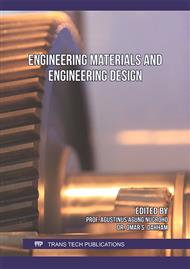[1]
Tian, Y., Qian, H., Cao, Z., Zhang, D., and Jiang, D., Identification of Pre-Tightening Torque Dependent Parameters for Empirical Modeling of Bolted Joints, Journal of the MDPI, Applied Sciences, 11, 2021.
DOI: 10.3390/app11199134
Google Scholar
[2]
Michael, W., Bolted Joint Preload Distribution from Torque Tightening, Journal of the Sciendo, Strojnícky časopis – Journal of Mechanical Engineering, 71(2), 2021, pp.329-342.
DOI: 10.2478/scjme-2021-0039
Google Scholar
[3]
Inoue, T., Sawada, T., Tanaka, K., and Kurashiki, T., Axial Force Measurement Using Digital Image Correlation, Transactions of the Japan Society of Mechanical Engineers, 88(912), 2022.
DOI: 10.1299/transjsme.22-00094
Google Scholar
[4]
Luo, H., Zhang, G., Zhang, J., and Shang, X., Influence of Transverse Vibration Amplitude on the Loosening of Bolted Joint by Finite Element Simulation, Journal of the IOP, Journal of Physics, 2213, 2022.
DOI: 10.1088/1742-6596/2213/1/012032
Google Scholar
[5]
Kadowaki, R., Inoue, T., Diagnosis of Bolt Loosening Using Transmitted Ultrasonic Pulse with Mode Conversion, Transactions of the Japan Society of Mechanical Engineers, 88(905), 2022.
DOI: 10.1299/transjsme.21-00258
Google Scholar
[6]
Tanno, Y., Estimation Method for Axial Tension of Various Bolted Joints Using Hydraulic Tensioner, Transactions of the Japan Society of Mechanical Engineers, 86(886), 2020.
DOI: 10.1299/transjsme.20-00036
Google Scholar
[7]
Fukuoka, T., Tightening Process of Bolted Joint with a Tensioner, Journal of the Nikkan Kogyo Shimbun, Machine Design, 41(12), 1997, pp.79-85.
Google Scholar
[8]
Kanno, Y., and Nagai, T., Tightening Test of Bolted Joint with a Bolt Tensioner, Journal of the Japan Bridge, Japan Bridge Technical Review, 1998, pp.22-29.
Google Scholar
[9]
Saeki, H., Bolt Fastening by Bolt-Tensioner, Journal of the Japan Society for Precision Engineering, 81(7), 2015, pp.633-637.
DOI: 10.2493/jjspe.81.633
Google Scholar
[10]
Fukuoka, T., Analysis of the tightening process of bolted joint with a tensioner using spring elements, Journal of Pressure Vessel Technology, 116, 1994, pp.443-448.
DOI: 10.1115/1.2929614
Google Scholar
[11]
Fukuoka, T., Analysis of the tightening process of bolted joint with a tensioner –Effects of interface stiffness-, Transactions of the ASME, ASME DE, 110, 2000, pp.119-125.
DOI: 10.1115/imece2000-2463
Google Scholar
[12]
Sawa, T., Tenma, K., Kobayashi, T., and Kurosawa, R., Finite Element Method Stress Analysis and Evaluation of the Sealing Performance in Box-Shape Flange Gasketed Connections Subjected to Internal Pressure, Journal of Pressure Vessel Technology, 139(5), 2017.
DOI: 10.1115/1.4037192
Google Scholar
[13]
Sawa, T., and Maruyama, K., The Force Ratio of Bolted Joints, Bulletin of the JSME, 22(165), 1979, pp.420-428.
DOI: 10.1299/jsme1958.22.420
Google Scholar
[14]
Verein Deutscher Ingenieure, VDI 2230-Blatt 1 Systematic calculation of high duty bolted joints, 2003.
Google Scholar
[15]
Lori, W. and Glaser, H., Berechnung der plattennachgiebigkeit bei schraubenverbindungen, Konstruktion, 46, 1990, pp.271-277.
Google Scholar
[16]
Nagata, S., Matsumoto, M., and Sawa, T., Stress analysis and sealing performance evaluation of pipe flange connections under internal pressure, Transactions of the Japan Society of Mechanical Engineers, Series A, 70(699), 2004, pp.1595-1602.
DOI: 10.1299/kikaia.70.1595
Google Scholar
[17]
Nakagome, M., Suzuki, I., Yasuda, K., and Mizuno, M., On the compliance and the load factor of bolted connections subjected to eccentric loading, Transactions of the Japan Society of Mechanical Engineers, Series C, 54(500), 1988, pp.960-967.
DOI: 10.1299/kikaic.54.960
Google Scholar
[18]
Sakai, T., Outline of Bolted Joint (Enlarged Edition), Yokendo, 2009, ISBN: 978-4-8425-0348-6.
Google Scholar


